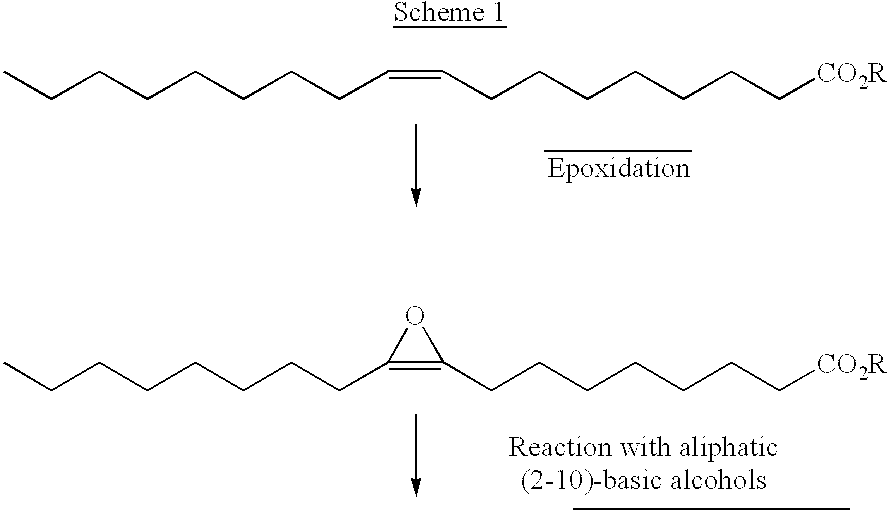Method of preparing casting and coating compositions using polyols derived from high oleic acid content fatty acid mixtures
- Summary
- Abstract
- Description
- Claims
- Application Information
AI Technical Summary
Problems solved by technology
Method used
Image
Examples
first embodiment
[0015] Both aromatic and aliphatic monocyclic and polycyclic isocyanate compounds having the functionality mentioned are suitable for the production of the isocyanate casting resins and coating compositions according to the invention. Thus, in a first embodiment, tolylene diisocyanate or diphenyl methane diisocyanate may be used as the aromatic isocyanate. Technical diphenyl methane diisocyanate containing diisocyanates of higher functionality and having an isocyanate group functionality of greater than 2 is particularly suitable. Another suitable aromatic diisocyanate is xylylene diisocyanate. In addition, a number of aliphatic isocyanates having a functionality of 2 or more may be used. Examples include isophorone diisocyanate, tris-(6-isocyanatohexyl)-isocyanate and dicyclohexyl methane diisocyanate as cyclic aliphatic diisocyanates. Other examples are aliphatic straight-chain diisocyanates obtained by phosgenation of diamines, for example tetramethylene diisocyanate or hexamethy...
examples
Raw Materials Used
[0023] Edenor MeTiO5: Fatty acid methyl ester mixture based on a fatty acid mixture with the following composition: 5% palmitic acid, 1% stearic acid, 67% oleic acid, 11% linolenic acid (a product of Henkel KGaA).
[0024] Edenor MeTiO5 is a raw material for producing a polyol for comparison purposes.
[0025] Priolube 1400: Fatty acid methyl ester mixture based on a fatty acid mixture with the following composition: 5% palmitic acid, 2% stearic acid, 67% oleic acid, 9% linolenic acid (a product of Unichema).
[0026] Priolube 1400 is a raw material for producing a polyol for comparison purposes.
[0027] NSf-Me-Ester: Fatty acid methyl ester mixture based on a fatty acid mixture (ex sunflower oil from new plants) with the following composition: 5% palmitic acid, 5% stearic acid, 85% oleic acid, 4% linoleic acid.
[0028] NSf-Me-Ester is a raw material for producing a polyol according to the invention.
Production of the Polyols
[0029] The fatty acid methyl ester mixtures mentioned ...
PUM
| Property | Measurement | Unit |
|---|---|---|
| colour stability | aaaaa | aaaaa |
Abstract
Description
Claims
Application Information
 Login to View More
Login to View More - R&D
- Intellectual Property
- Life Sciences
- Materials
- Tech Scout
- Unparalleled Data Quality
- Higher Quality Content
- 60% Fewer Hallucinations
Browse by: Latest US Patents, China's latest patents, Technical Efficacy Thesaurus, Application Domain, Technology Topic, Popular Technical Reports.
© 2025 PatSnap. All rights reserved.Legal|Privacy policy|Modern Slavery Act Transparency Statement|Sitemap|About US| Contact US: help@patsnap.com

